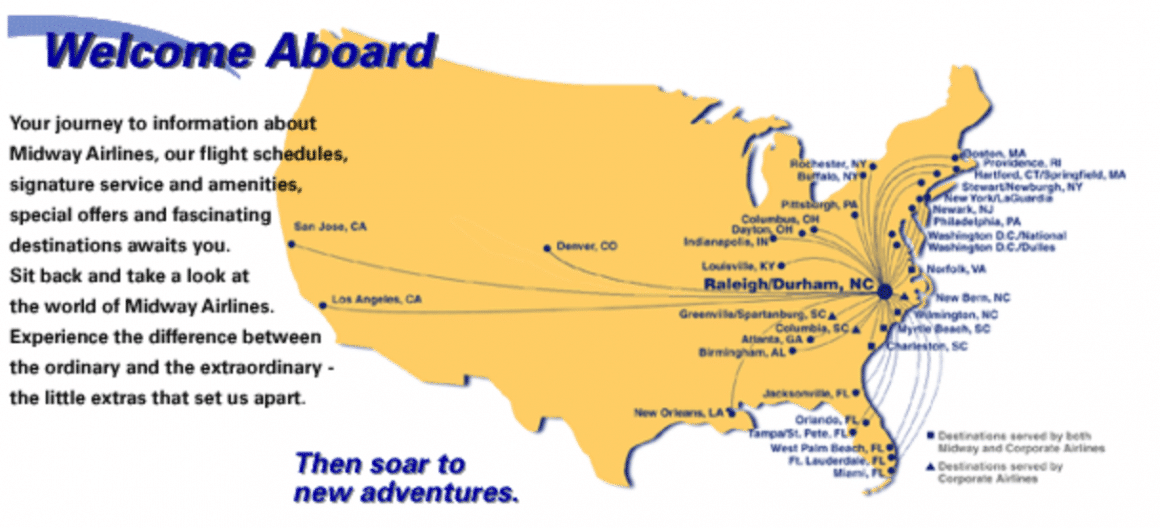Airlines exist to make money. They establish new markets to serve business opportunities. In some cases, they add new service to cripple other competitors on the same route (case in point American vs Legend). In some cases, airlines even shift major parts of their network away from existing hubs. TWA used to have a large presence in Chicago. They shifted much of their network to St. Louis with the acquisition of Ozark. What makes this story unique is never has an airline completely abandoned its namesake airport. That was until the second incarnation of Midway Airlines came around.
Midway Airlines and its reincarnation

The original Midway Airlines came about at the dawn of airline regulation. For years, Midway Airport was the busiest airport in the world. The landlocked airport limited growth though. The newer and more spacious O’Hare opened in the 1960s leaving Midway Airport nearly abandoned. The founders of the original airline saw opportunity in the nearly abandoned airport on Chicago’s south side. Midway started service with used DC-9s in 1979.
The airline grew and prospered over the next decade to become one of the top 10 airlines in the nation. The original Midway was loved for their attention to detail and quality service. A poor business decision to purchase Eastern’s Philadelphia operation combined with the economic downturn in 1991 led to the airline’s demise.
That wasn’t the end of the Midway name though. In 1993, a group of investors, led by one of the original founders of Midway Airlines, sought to resurrect the name and the airline’s former glory. Armed with investment capital, they leased a pair of Fokker F-100s and began service to New York LaGuardia. They eventually added service to Washington DC, Dallas/Fort Worth, Denver, and Allentown, PA. The new Midway had nice jets with leather seating, hot towels, and sandwiches on flights just like the original.
The airline struggled though. The market had changed drastically in just the two years since their namesake dominated the south side airport. After the original Midway went out of business, Southwest Airlines swooped in to purchase rights to a sizable amount of gates. By time Midway restarted service, Midway Airport was full of competition from the likes of Southwest, ATA, US Air, and Northwest Airlines along with upstart competition from Kiwi International Airlines, Air South, ValuJet, and other. With a limited budget to spend on advertising, half-full flights, and limited prospects for a profitable expansion from Midway Airport, Midway Airlines made a very unique next move.
Midway moves its hub, then abandons its namesake airport
In January of 1995, Midway made one of the most unique moves in the airline industry. They signed a deal with American Airlines to take over American’s Raleigh Durham hub. As part of the agreement, Midway would gain access to more sustainable east coast north south routes. They also would gain access to the lucrative American AAdvantage frequent flyer program. The airline ceased all but one route from Chicago Midway. The flight that remained was a non-stop flight from Midway to RDU.
As part of the move, the airline added Airbus A320 service to Cancun and Los Angeles to compliment their fleet of Fokker F-100s. Midway would later add CRJ-200s and Boeing 737-700s and completely server ties from Chicago as they dropped all service to the city and moved their headquarters to the Research Triangle region. They even added connecting service to Raleigh under the Midway Connection brand through a partnership with Great Lakes Airlines.For a few years, Midway was profitable. That was until Southwest Airlines once again came to spoil their party.

In 1999, Southwest announced that they would add RDU as their first service to North Carolina. Just a few years earlier, Southwest had unlocked the Florida market to great success. Southwest had beat back competitors with lower operating costs that translated into lower fares. Midway, with higher operating costs and faltering economy, was hit hard. To shore up their balance sheet, they planned to remove the Fokker fleet from service.
In August of 2001, Midway declared bankruptcy and cut service to most west coast cities. Just a month later, September 11th struck. Midway announced that they would cease service but still applied for a loan under post 9/11 legislation. When they received the money, they began service again with just the Boeing 737-700 fleet. In 2002, the airline suspended their own-brand service for a second time. The airline then provided service for US Airways Express utilizing their CRJ-200s before finally folding for good in 2003.
The Real Head Scratcher–Why Did They Keep The Midway Name?
While Midway moved from its hub in Chicago, it was always kind of odd that they kept the Midway Airlines name. To our best research, it was the only airline ever to fully abandon its namesake hub. Why did they keep it? Some former Midway workers we talked to mentioned that the name had a solid reputation for safe and quality service. Some people joked that the airline kept the Midway name because it was halfway between New York and Florida. At the end of the day, it came down to a business decision.
As much as the original employees of Midway II loved their hometown of Chicago Midway, the airline was unlikely to be successful at its original home. The move to RDU gave Midway II new life for a time. And while the airline eventually succumb to external economic forces, the yellow tails made an impression on people on the east coast for their Carolina Class service.
Editors note: The original article stated that Midway II moved to the Golden Triangle region instead of the Research Triangle region. This has since been corrected.
